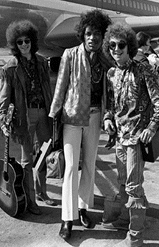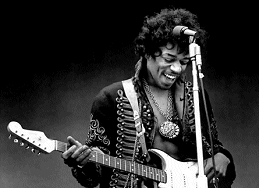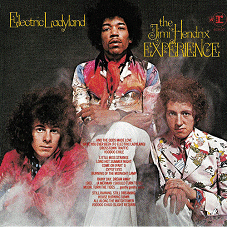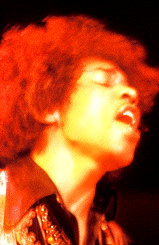Sixties
City presents
a wide-ranging series of
articles on all aspects of the Sixties, penned by the creator of the iconic
60s music paper Mersey
Beat
|
Sixties
City presents
a wide-ranging series of
articles on all aspects of the Sixties, penned by the creator of the iconic
60s music paper Mersey
Beat
|
|||||
|
| The
third album by Jimi Hendrix with his original Experience was a million-seller
that topped the American charts and provided him with his only American
chart-topping single, his version of Bob Dylan’s ‘All Along The Watchtower’
(it reached No.5 in Britain) while ‘Crosstown Traffic’ reached No.37 in
the British charts. Incidentally, as a piece of trivia, ‘All Along the Watchtower’
(from the ‘John Wesley Harding’ album) was the only Bob Dylan cover Jimi
ever recorded and, coincidentally, Dylan’s surname can be found in the title
of the album. The double album has Jimi backed by John 'Mitch' Mitchell on drums and Noel Redding on bass: the members of the Jimi Hendrix Experience. Additional musicians were Al Kooper, Stevie Winwood, Jack Cassidy, Buddy Miles, Chris Wood, Freddie Smith, Mike Finnigan and Larry Faucette. The album, 76 minutes in length, was recorded in New York and London between June 1967 and June 1968 and issued in America on Reprise on 16th October 1968 and in Britain on Track Records on 25th October. Jimi penned most of the original material and Noel Redding composed the track ‘Little Miss Strange’. The live track ‘Voodoo Child’ has Stevie Winwood playing organ and Jack Cassidy of Jefferson Airplane on bass. The tracks were: And All The Gods Made Love; (Have You Ever Been To) Electric Ladyland; Crosstown Traffic; Voodoo Child; Rainy Day, Dream Away; 1983 (A Merman I Should Turn To Be); Moon, Turn The Tide…Gently, Gently Away; Little Miss Strange; Long Hot Summer; Come On; Gypsy Eyes; the Burning Of The Midnight Lamp; Still Raining, Still Dreaming; House Burning Down; All Along The Watchtower; Voodoo Child (Slight Return). There were problems at the recording sessions, which caused producer/manager Chas Chandler to abandon the production and sell his management shares to Mike Jeffrey. Chas produced ‘Crosstown Traffic’, The Burning Of The Midnight Lamp’ and ‘All Along the Watchtower’, but wasn’t prepared to continue after the problems recording ‘Gypsy Eyes’ at the Record Plant in New York. Chas commented, “Drugs didn’t get in the way of shows, and it didn’t get in the way of recording, but I thought it was getting in the way of his brain…mainly acid. It was fu**ing madness”. The track actually took 41 takes and Chas said: “Jimi would turn up at the studio with a dozen hangers-on who you’ve never seen before in your life. You used a sort of shorthand conversation in the studio when there’s nobody around but when there’s an audience around, people get uptight. It changes the atmosphere in the studio. He wanted me to go over and over songs, some things he’d got in the first take. I just couldn’t communicate with him. I felt like an alien". Eric Burdon was to say, “Would he listen to Chas? No. So Chas got to the point of like, ‘Oh, I can’t deal with that crazy nigger any more, it’s too much of a drain on me’ and so the window of opportunity was there for Mike Jeffrey to walk right in and scoop it all, and I knew that something dodgy was gonna happen. But I never dreamt it would lead to his death". |
 |
 |
The British
sleeve of Electric Ladyland was considered too risqué. Many shops sold the
album in brown paper bags! Hendrix himself disliked the cover and said it
detracted from the music. The record company was happy with the controversy
and publicity. The idea for the cover came from Chris Stamp and David King,
art director of Track Records. Stamp sent King and photographer David Montgomery to the Speakeasy club in Margaret Street to get some girls who were offered £5 a head to pose for the sleeve and £10 if they agreed to pose with their knickers off. One of the 19 girls, Reimie Sutcliffe, told the music paper Melody Maker, “It makes us look like a load of old tarts. It’s rotten. Everyone looked great but the picture makes us look old and tired. We were trying to look too sexy, but it didn’t work out". Jimi took one look at the sleeve and said he’d have nothing to do with it. The cover was replaced with a photograph of Jimi by Reprise in America and the British gatefold image was also absent from the U.S. release. This was a photograph taken by David Montgomery during a photo session at the Roundhouse in London on 16th November 1967 for a Sunday Times feature. When the feature didn’t appear it was decided to use the image as part of the album package. Montgomery recalled, “It was actually pretty hairy. We poured a line of petrol about 15 feet across and we lit it. He was standing in front of it – he could have had his head blown off. The flames go up about 15 feet high". Jimi had wanted a photograph by Linda McCartney to grace the cover and, when the naked ladies image was used, Linda commented, “I think everybody thought it was his idea. We did get something in the American cover, which had an open-out cover. All the photographs inside were black and white, which I took. They showed him as a human being, rather than a freak, you know”. The cover photograph of the Reprise album was by Karl Ferris. |
 |
|
 |
||
|
Article
Text
UK
web hosting by
|